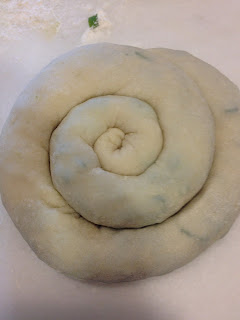This is a situation where mother does not know best. There are 2 ways to make scallion pancakes: the liquid pancake batter version, and the dough version with layers. My mother always made the former, and I always preferred the latter, so I this morning I decided to experiment a little.
A coworker mentioned an old family recipe over dinner that involves rolling the dough and the re-rolling it to make the layers. I've heard of this method, but it got me thinking...
I want the pancakes to be nice and flakey, so that means less water. I decided to use hot water dough, because it requires less water. I poured boiling water into 1.5 cups of flour while stirring rigorously with a fork until it looks clumpy like the second picture. It probably took at most 0.5 cups of water.
I then kneaded the dough until it's homogenous. Be careful - it's hot. Then I covered the bowl and let it sit.
The defining ingredient of scallion pancakes has to be sliced very thinly, unlike the recipe for pajeon, which are korean pancakes. I just realized that I never posted about them, which is kind of surprising... But that's for another day when I have a few other ingredients.
Prep: I mixed some vegetable oil and sesame oil which will be both the oil that goes into the pancake, and the pan frying oil. The dough was separated into smaller pieces. With several dough balls, I can make the pancakes in several different ways and figure out how I like them the best.
Dough: I find that it's best to roll the dough into very thin long rectangular shapes. This is to make your life easier in later steps.
Filling: Since in Chinese, these are called cong you bing, or scallion *oil* pancake, you should be a little generous with the oil. I find that the best amount is just enough such that your fingers can move smoothly over the surface of the dough, but not so much that you can collect pools of oil. I also like to make sure that the oil goes all the way to the near edge, where you're going to start rolling. That way you get the maximum number of layers.
In the picture above is about the maximum amount of scallions you should put on your dough. I would use somewhere between 50%-75% of the amount shown in the picture for the best results.
You then roll up the dough, gathering the scallions into the roll as you go. I find that you don't have to wind this up so tightly such that there's tension on the dough, but don't wind it up so loosely that there are big air bubbles either. A few air bubbles never hurt a pancake.
The coil can also be somewhat relaxed. Just make sure to fold the end under the coil (seen in the picture above) so that it doesn't come apart.
To reflatten the dough, you can press it down with the palm of your hand, or go over it a few times VERY CAREFULLY with a rolling pin. The one above is by far the flattest of my pancakes.
Making this coil much bigger is almost impossible. This is why the dough should start off as a long rectangle, so you don't have to get too messy at this step.
Here is the one with the best coil tightness vs. pancake flatness. They are then pan fried in about a tablespoon of oil. You definitely want enough oil such that it really cooks into the dough and imparts that nutty flavor. The oil must be hot enough such that the moment you lower the pancake into the pan, you can hear the sizzle.
They're fried until golden brown.
I like to serve them with a spicy sauce.
I made a big old pile of these with varying flatness, amounts of oil/scallion, and coil tightness. I cut them up and went over each with the bf.
His favorite was what he called "the donut" which was just the coil very lightly smushed with the palm of my hand. I was a little upset... this was by far the easiest to make, and would have saved me a lot of smushing, rolling, and cleaning time. When you roll out the coiled pancake, wet dough and oil get onto the work surface, and then you have to clean it a little before the next pancake.
My favorite was the one that I've been describing in the recipe above: generous amount of oil with a sprinkling of scallions, and a relatively loose coil. The thinness means that the oil inside the layers of the pancake also cooked, making layers of fluffy crust.
I'm so glad that I finally have a go-to scallion pancake recipe... and that I can make half of them without doing the last step of re-rolling the coil!






















No comments:
Post a Comment